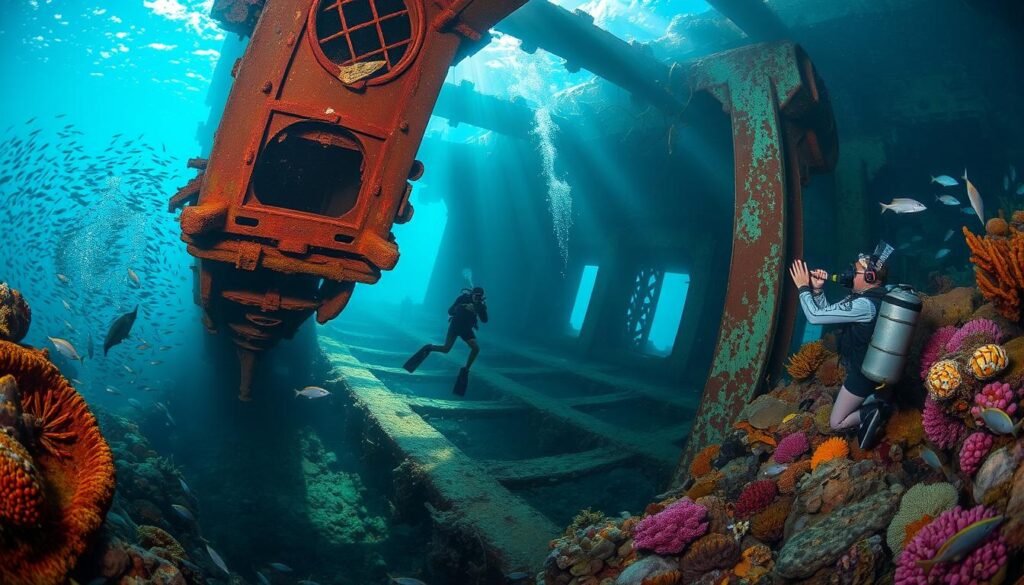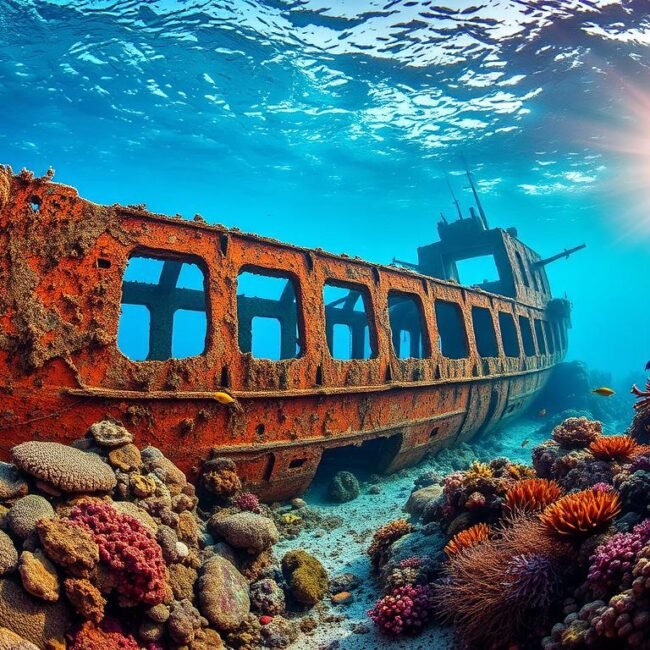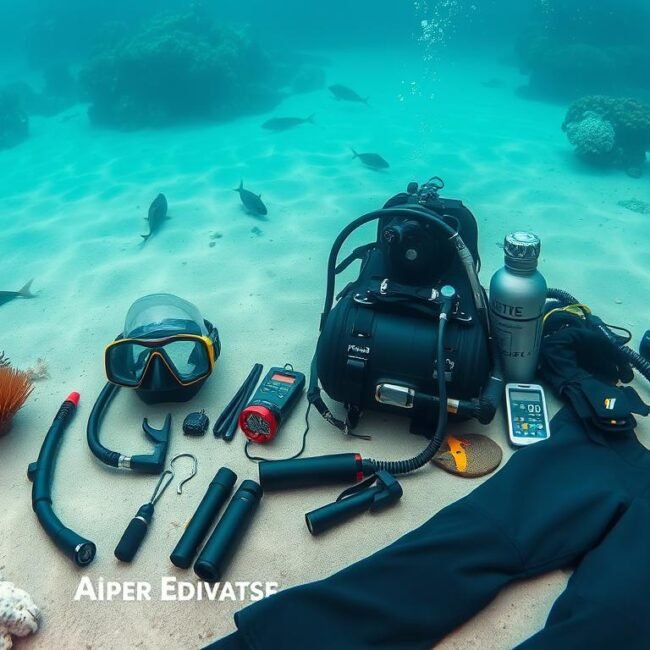“Wreck diving isn’t just a hobby—it’s an adventure that fuses history, exploration, and a dash of adrenaline!” That’s what a friend once told me. I still remember my first dive to see a sunken ship. It was amazing, filled with mystery.
Over the years, I’ve learned safety is key. That’s why I’m excited to share safety tips for wreck diving with you today. These tips are for everyone, whether you’re experienced or new to diving. They’ll help you stay safe and enjoy your dives.
Understanding the Basics of Wreck Diving
Wreck diving is like time travel with a scuba tank. You see history, not just fish and coral. My first dive was amazing, with an old porcelain sink still there, telling its story.
Definition of Wreck Diving
Wreck diving means exploring underwater structures, like ships. It can also be old airplanes or tanks. Even a sunken subway car turned reef is explored. If it’s big, underwater, and has history, it’s a wreck. They’re all fascinating.
Why Wreck Diving Differs from Reef Diving
Wreck diving is different from reef diving. On reefs, you focus on buoyancy and marine life. But wrecks have extra dangers. Entanglement and limited visibility are big risks. Plus, metal edges can hurt you if you’re not careful.
The Fascination Behind Wreck Diving
So, why do we dive wrecks despite the dangers? It’s the mix of history, archaeology, and marine biology. Each wreck has its own story. Nature turns them into reefs, full of life. It’s a humbling sight.
For me, each wreck is a mystery to solve. Who was on board? What were they carrying? These questions excite me. Sometimes, you find old fixtures or personal belongings. It’s like an underwater treasure hunt.
Wreck diving is all about challenge, excitement, and a deep connection to history. It’s not like diving on a reef. To do it safely, you need to be respectful, cautious, and curious. Once you start, you might get hooked on this unique diving world.
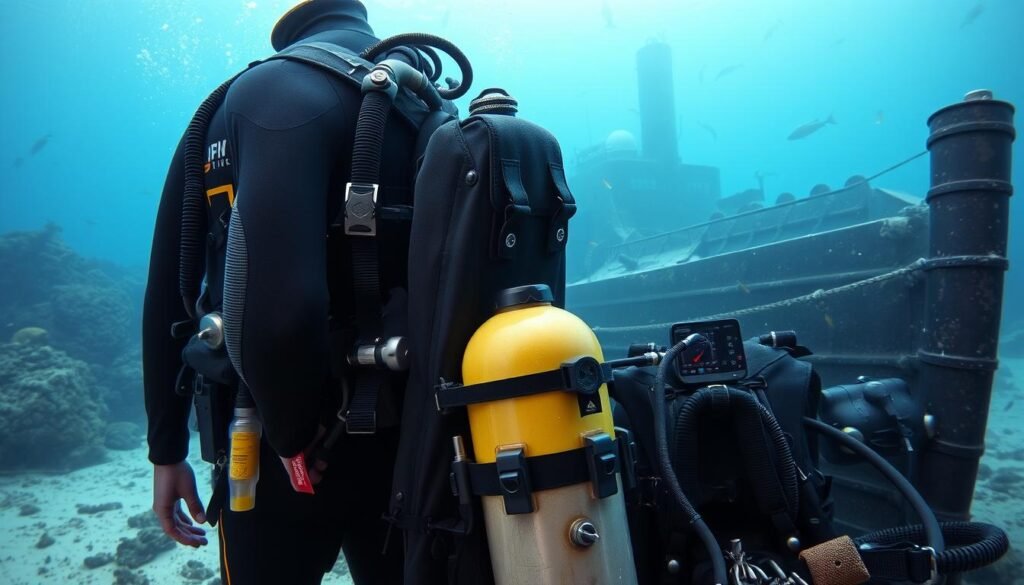
Pre-Dive Preparation
Many people say they’ll figure things out when they get there. But wreck diving is different. You need good planning to avoid emergencies. Proper preparation can make your dive unforgettable or a disaster.
Get the Right Training
First, get the right training. You can’t just wing it with wreck diving. You need at least an Advanced Open Water certification for deep dives. For wreck penetration, a Wreck Specialty certification is best. These courses teach you how to use reels and navigate overhead environments.
Hands-on training is key. Some dive centers offer training in pools or shallow waters. This helps build your confidence for real wreck dives.
Research the Dive Site
Knowing the dive site is crucial. Gather all the information you can before diving. Check the depth, structure, and any hazards like fishing nets. Weather and water conditions also matter. Always check the forecast before diving.
Plan Your Dive, Dive Your Plan
Plan your dive carefully. Create a dive profile with your depth, bottom time, and decompression stops. Stick to your plan. Emergencies can happen anytime, so always have a backup plan.
Preparing for a wreck dive is more than just checking boxes. It’s about being ready so you can enjoy the dive. The more prepared you are, the more you can focus on the adventure.
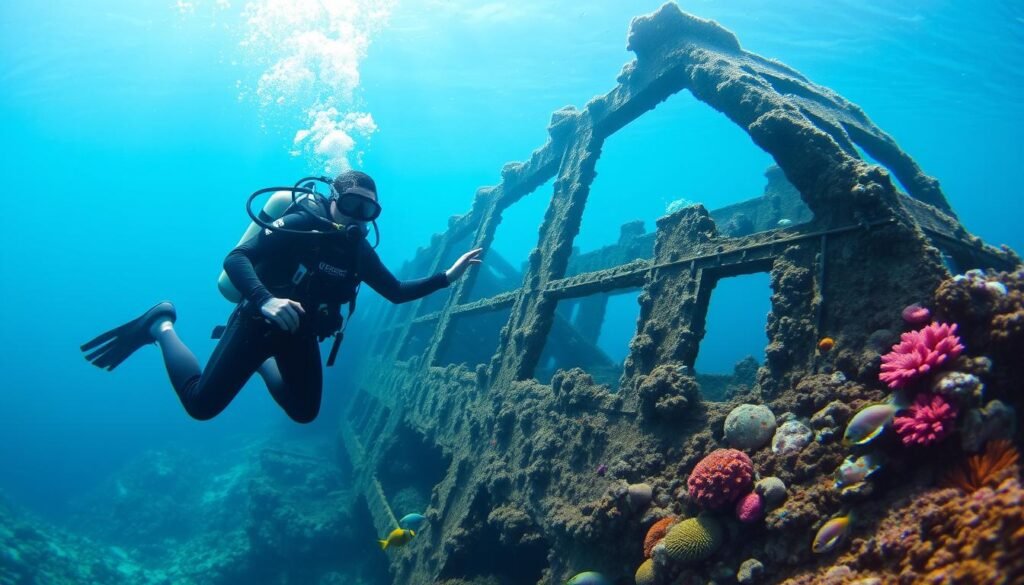
Essential Equipment for Wreck Diving
When I started wreck diving, I thought my regular scuba kit was enough. But soon, I realized I needed special gear. Over time, I’ve added tools that have saved my life. Here are my essential items for a safe wreck dive.
Primary & Backup Lights
Visibility can change quickly in a wreck. A good dive light is essential. I once lost my main light due to a bad battery. Luckily, I had a backup on my BCD and made it out safely.
Always bring a primary and backup light. It’s even better if your buddy has one too. This is crucial for exploring dark areas.
Reel or Spool
A reel might look like string, but it’s vital for wreck exploration. Secure one end at the entrance and unwind as you go in. It helps you find your way back if visibility drops.
I used to think reels were unnecessary. But, when I got lost in a silt-filled corridor, I realized how important they are. A reel can save you from panic.
Redundant Air Supply
Carrying a pony bottle or stage cylinder is wise for deeper dives. It’s a lifesaver if your main tank runs out or your regulator starts to leak. It might seem heavy, but the peace of mind is worth it.
I felt relieved knowing I had extra air. It’s a crucial safety measure.
Proper Exposure Protection
Water temperatures can vary greatly, even in warm places. Wear the right wetsuit or drysuit to stay comfortable. Old metal surfaces can be sharp, so a full suit protects you from cuts.
I learned this the hard way when I scraped my calf. It was painful.
Dive Computer & Compass
A reliable dive computer is key for tracking your dive. Wrecks can be so captivating that you might dive too deep or stay too long. A compass helps navigate, especially in complex wrecks.
It’s easy to get lost in the excitement of exploring. Make sure you have these tools to ensure a safe dive.
Having the right gear doesn’t guarantee a perfect dive. But, it does increase your chances. Wrecks can be unpredictable. Always be prepared and double-check your gear before diving.
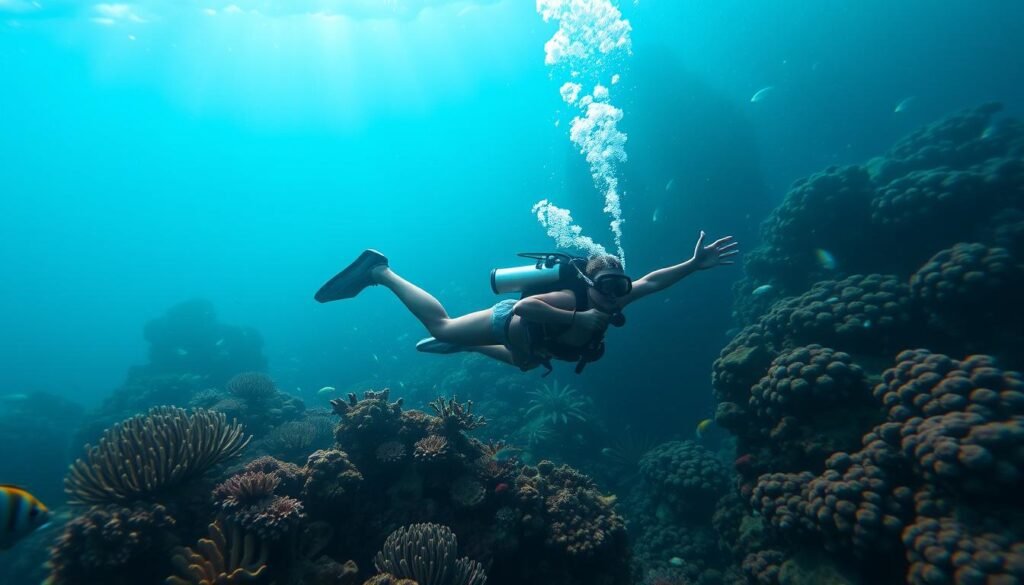
Tips for Safe Wreck Penetration
Exploring a wreck is like entering another world. It’s both thrilling and intimidating. My first time inside a wreck, my heart was racing with excitement and fear.
With the right approach, it’s an unforgettable experience. But, if you’re not careful, it can turn into a nightmare. Here’s how to stay safe and have fun.
Assess Your Comfort Level
Before diving into a wreck, be honest with yourself. Are you comfortable in tight spaces? If you get anxious or uncomfortable, it’s best to stay outside.
I’ve seen divers ignore their comfort zones and panic inside. Don’t be that person. Know your limits and start with the exterior or open areas until you feel more confident.
Maintain Excellent Buoyancy
Buoyancy is key for safe wreck diving. If you’re bouncing off walls, you’ll damage the wreck and possibly harm marine life. You could also stir up silt, making it dark.
One time, I flared my fins too hard in a narrow passage. It took us a few minutes to regain partial visibility. Before diving, practice buoyancy control in open water or a pool.
Use a Guideline
A guideline reel is your safety net when diving in wrecks. Tie off at the entrance and play out the line as you go deeper. It’s crucial if you get lost or visibility drops.
I once saw a diver try to rely on memory alone. It didn’t end well. They took a wrong turn and ended up in a random compartment. Luckily, it had another exit. A reel line ensures you can always find your way back.
Avoid Disturbing Artifacts
It’s tempting to take an old bottle or trinket as a souvenir—don’t. Removing artifacts is illegal and can damage the wreck. It’s also unethical, as these items are part of history.
I recall spotting an old plate on a sunken ship. It still had its pattern visible. I took a picture and left it where it was. Sharing that photo with friends was way cooler than taking the plate.
Penetrating a wreck can be thrilling or a cautionary tale. Proper training, the right gear, and respect for your surroundings are key. This way, you’ll enjoy the experience safely.
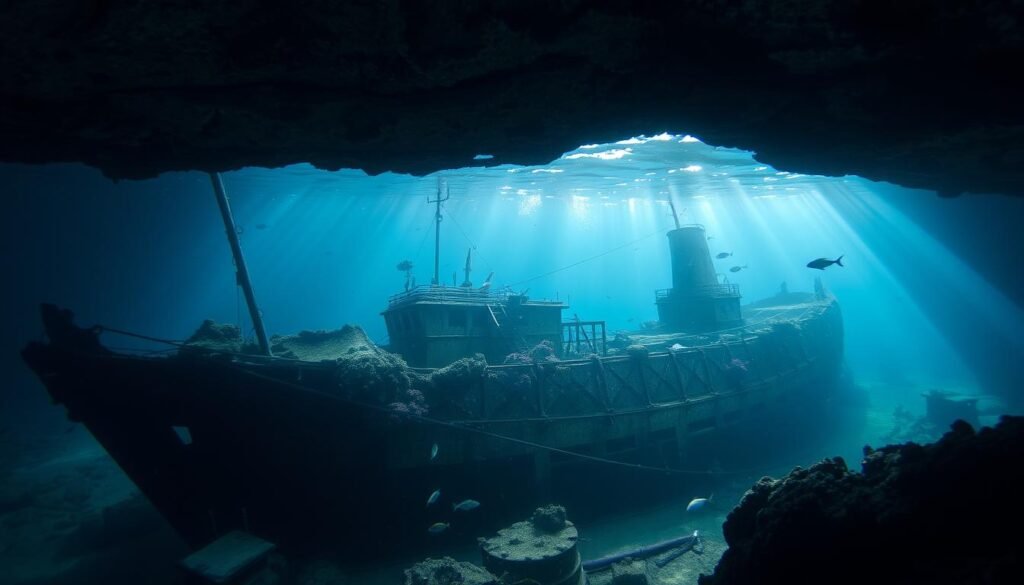
Common Hazards and How to Avoid Them
Wreck diving isn’t just a casual swim. It comes with real dangers that can turn your dive into a nightmare if you’re not ready. I’ve had my share of close calls, like almost getting my fin stuck in old fishing nets. The panic was intense, but I managed to free myself quickly.
Here are the most common dangers you’ll face and some Safety Tips for Wreck Diving to keep you safe.
Entanglement
Wrecks are full of ropes, fishing lines, and cables. You might be exploring and then your fin gets caught. To avoid this, keep your gear tidy. Secure loose items like console hoses and camera straps.
If you get caught, don’t panic. Stop, look, and untangle yourself carefully. A small cutting tool can be a lifesaver for tough snags.
Poor Visibility or Silt-Out
Wrecks can stir up silt, sand, or rust, making the water murky. A single kick can cloud the water quickly. Move slowly and use a frog kick to avoid stirring up silt.
Always have a guideline when diving in dark or murky water. It helps you find your way out.
Disorientation
It’s easy to lose your bearings inside a wreck, especially if it’s lying on its side. Use your dive computer, compass, and guideline to stay oriented. Many wrecks have complex layouts with multiple decks and corridors.
Rely on reference points like lines, your buddy, or visible exits to avoid getting lost.
Unstable Structures
Wrecks can collapse if you touch them too hard or lean on them. Treat them like an old building—don’t sit on the floor. Avoid unnecessary contact with the wreck. If you need to stabilize yourself, do so gently on stable sections.
Watch out for rust flakes or barnacles that can cut your gloves and skin.
Being aware of these hazards will make your wreck dives safer and more enjoyable. A calm and careful approach is best. The ocean and wrecks are dynamic, so respect them for a great dive experience.
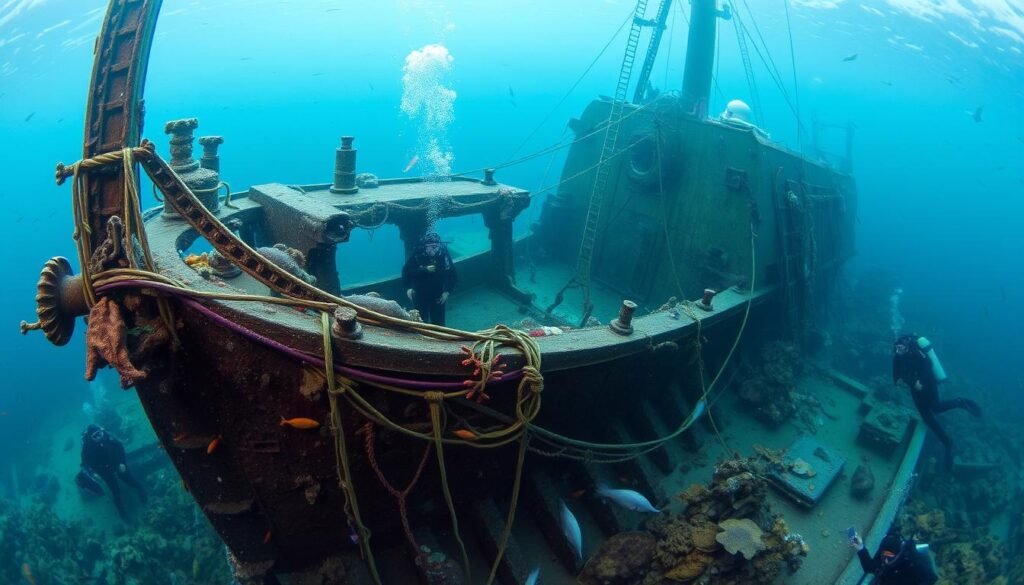
“Wreck diving is an adventure, but it’s not one to be taken lightly. Proper training, equipment, and situational awareness are essential to mitigate the risks and ensure a safe and memorable experience.”
Post-Dive Best Practices
After a great wreck dive, you might be high-fiving your buddy while the boat crew smiles. But your work isn’t over. The actions you take after diving can improve your skills, keep your gear in top shape, and prepare you for safer dives in the future. I’ve found that a good post-dive ritual is like closing the chapter on an adventure and getting ready for the next one.
Conduct a Debrief
I believe every dive is a chance to learn. After diving, take time to talk about what worked and what didn’t. Discuss how you handled surprises or any mistakes.
For example, I once struggled with buoyancy in a narrow passage. My buddy suggested practicing frog kicks in open water. This simple tip helped a lot later on.
Log Your Dive
Logging dives is more than just collecting stamps. It helps you track important details like depth and water temperature. This is key for improving your wreck diving skills.
You might notice patterns, like using more air at certain depths. Identifying these can help you focus your training. Plus, logging dives is often required for advanced courses.
Proper Equipment Maintenance
Wreck dives can be tough on your gear. Make sure to rinse it in fresh water as soon as you can. Pay extra attention to reels and lights, as they can get dirty or flooded.
Always check your dive computer and regulator for any issues. If something seems off, get it checked by a pro. You don’t want equipment failure on your next dive.
If you used a backup tank, make sure it’s full and checked before storing it. Many divers forget this, leading to last-minute scrambles at the dive shop.
Post-dive practices might not be as thrilling as the dive itself, but they’re crucial. Debriefing, logging your dive, and maintaining your gear improve your skills and safety. Reflecting on your dive can also be a special moment.
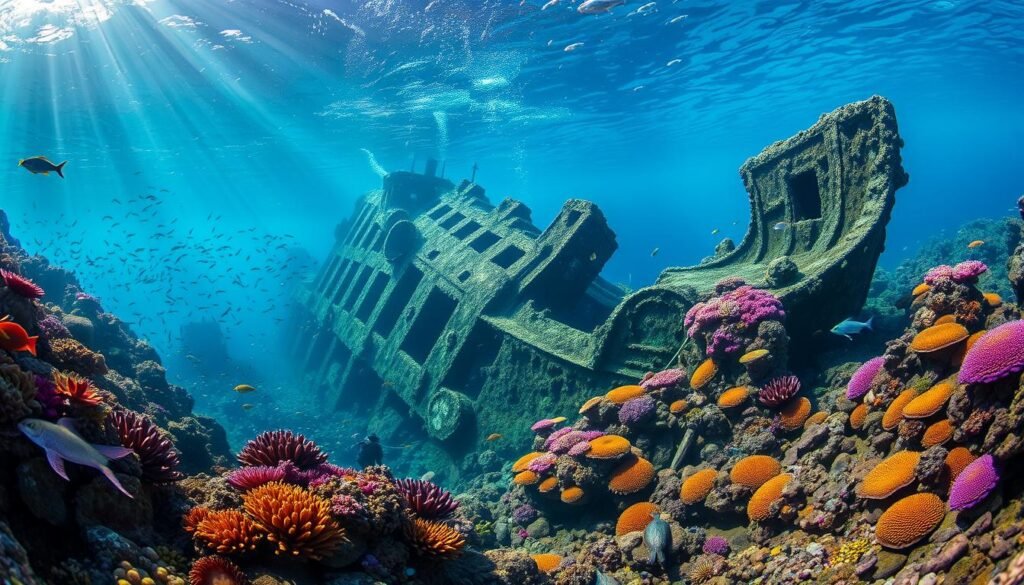
Conclusion
Wreck diving is a mix of history, adventure, and underwater wonder. But it comes with challenges that require preparation and respect. From understanding wrecks to maintaining your gear, every step is important for safety.
If you’re drawn to these underwater treasures, train well, research your site, and use the right gear. Each wreck is a piece of history we must explore safely and ethically.
I’d love to hear your wreck diving stories and tips. Sharing helps us all learn and stay safe. Drop your experiences in the comments and let’s keep the conversation going. Stay curious, prepared, and ready for new adventures with these safety tips for wreck diving. Safe dives and happy exploring!
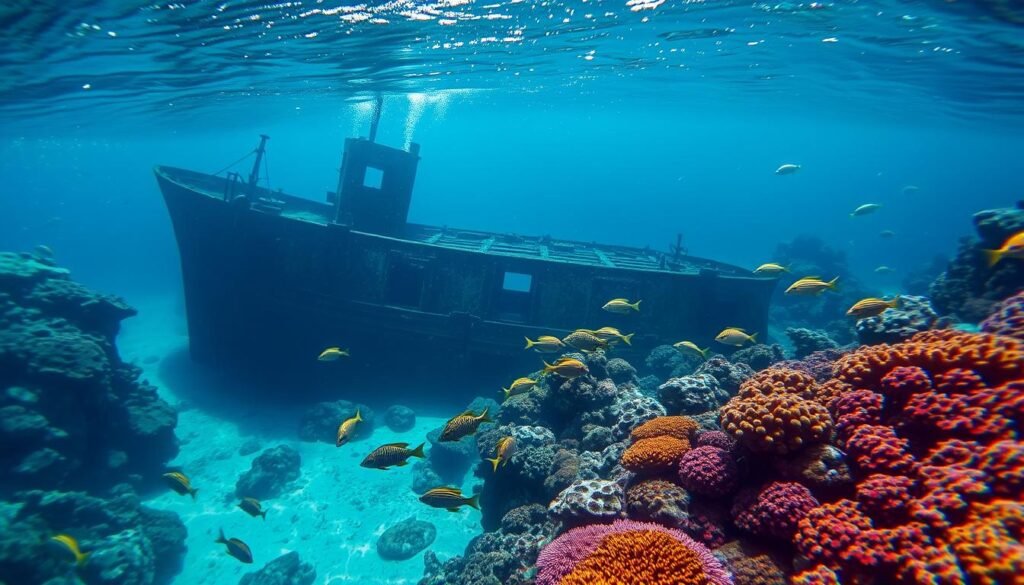
“Careful planning and adaptability are the keys to safe and successful wreck dives.”
FQAs
Do I need a special certification to go wreck diving?
Yes, it’s highly recommended. An Advanced Open Water or Wreck Specialty certification ensures you’ve practiced essential skills, like using a guideline reel and maintaining proper buoyancy in overhead environments.
What gear is essential for a safe wreck dive?
You’ll need more than just scuba gear for wreck diving. Make sure you have at least one dive light, a guideline reel or spool, and a backup air source like a pony bottle. These are crucial for deeper dives or complex wrecks.
How do I handle poor visibility or silt-outs inside a wreck?
Move slowly and use precise finning, like the frog kick. Always keep a guideline secured. If visibility drops, stop, stay calm, and follow the line back to the exit.
What should I do if I get entangled in netting or cables?
First, stay calm. Then, try to free yourself without thrashing. Having a cutting tool or line cutter can help you safely remove any snags.
Is it okay to remove artifacts from a shipwreck?
Generally, no. Removing items is often illegal and can damage the site’s historical value. Responsible wreck divers leave everything in place, preserving these underwater time capsules for future explorers.

